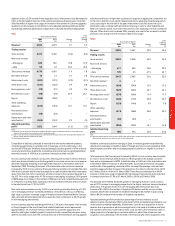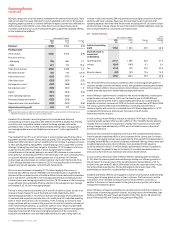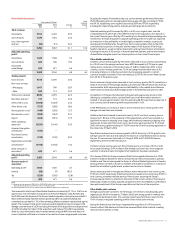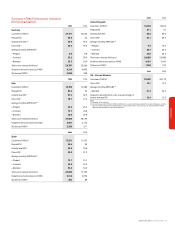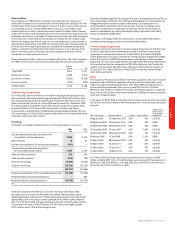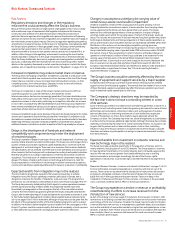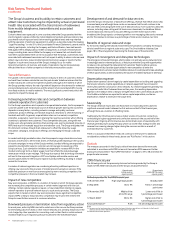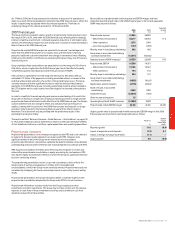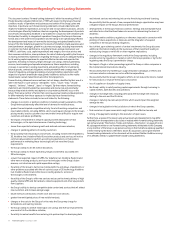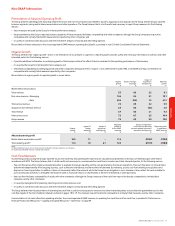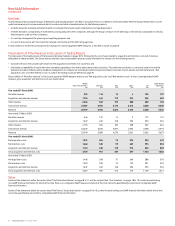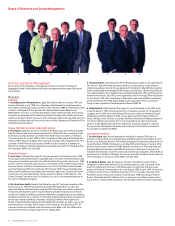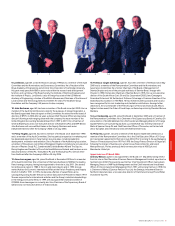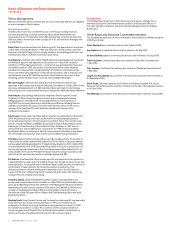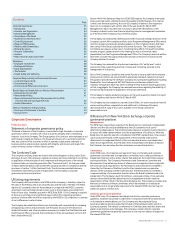Vodafone 2006 Annual Report Download - page 45
Download and view the complete annual report
Please find page 45 of the 2006 Vodafone annual report below. You can navigate through the pages in the report by either clicking on the pages listed below, or by using the keyword search tool below to find specific information within the annual report.
Vodafone Group Plc Annual Report 2006 43
Risk Factors, Trends and Outlook
Risk Factors
Regulatory decisions and changes in the regulatory
environment could adversely affect the Group’s business.
Because the Group has ventures in a large number of geographic areas, it must comply
with an extensive range of requirements that regulate and supervise the licensing,
construction and operation of its telecommunications networks and services. In
particular, there are agencies which regulate and supervise the allocation of frequency
spectrum and which monitor and enforce regulation and competition laws which apply to
the mobile telecommunications industry. Decisions by regulators regarding the granting,
amendment or renewal of licences, to the Group or to third parties, could adversely affect
the Group’s future operations in these geographic areas. The Group cannot provide any
assurances that governments in the countries in which it operates will not issue
telecommunications licences to new operators whose services will compete with it. In
addition, other changes in the regulatory environment concerning the use of mobile
phones may lead to a reduction in the usage of mobile phones or otherwise adversely
affect the Group. Additionally, decisions by regulators and new legislation could affect the
pricing for, or adversely affect the revenue from, the services the Group offers. Further
details on the regulatory framework in certain countries and regions in which the Group
operates, and on regulatory proceedings can be found in “Regulation” on pages 21 to 24.
Increased competition may reduce market share or revenue.
The Group faces intensifying competition. Competition could lead to a reduction in the
rate at which the Group adds new customers and to a decrease in the size of the Group’s
market share as customers choose to receive telecommunications services, or other
competing services, from other providers. Examples include, but are not limited to,
competition from internet-based services and MVNOs.
The focus of competition in many of the Group’s markets continues to shift from
customer acquisition to customer retention as the market for mobile
telecommunications has become increasingly penetrated. Customer deactivations are
measured by the Group’s churn rate. There can be no assurance that the Group will not
experience increases in churn rates, particularly as competition intensifies. An increase
in churn rates could adversely affect profitability because the Group would experience
lower revenue and additional selling costs to replace customers, although such costs
would have a future revenue stream to mitigate the impact.
Increased competition has also led to declines in the prices the Group charges for its mobile
services and is expected to lead to further price declines in the future. Competition could
also lead to an increase in the level at which the Group must provide subsidies for handsets.
Additionally, the Group could face increased competition should there be an award of
additional licences in jurisdictions in which a member of the Group already has a licence.
Delays in the development of handsets and network
compatibility and components may hinder the deployment
of new technologies.
The Group’s operations depend in part upon the successful deployment of continuously
evolving mobile telecommunications technologies. The Group uses technologies from a
number of vendors and makes significant capital expenditures in connection with the
deployment of such technologies. There can be no assurance that common standards
and specifications will be achieved, that there will be inter-operability across Group and
other networks, that technologies will be developed according to anticipated schedules,
that they will perform according to expectations or that they will achieve commercial
acceptance. The introduction of software and other network components may also be
delayed. The failure of vendor performance or technology performance to meet the
Group’s expectations or the failure of a technology to achieve commercial acceptance
could result in additional capital expenditures by the Group or a reduction in profitability.
Expected benefits from integration may not be realised.
The One Vodafone programme represents the Group’s principal plan to achieve
integration across the Group’s operating companies, particularly in Europe, and is
designed to maximise the benefits of Vodafone’s scale and scope. The programme is
premised on six core initiatives, further details of which can be found on pages 18 to 19.
The Group has previously stated publicly that it expects to realise operational revenue
benefits by the year ending 31 March 2008. These expected benefits have been
formulated by management on the assumption that all of the core initiatives which
comprise the One Vodafone programme generate the results anticipated and that the
Group is able to take advantage of its size and exploit the associated economies of scale
to their fullest extent. Management considers these targeted revenue enhancements
set out on pages 18 to 19 to be achievable, although no assurance can be given that the
full extent of the anticipated benefits of the One Vodafone programme will be realised.
In addition, the ability to deliver tangible business benefits from the convergence of the
Group’s IT systems could be compromised by the technical complexity of such a process
or other difficulties associated with converging multiple systems architectures.
Changes in assumptions underlying the carrying value of
certain Group assets could result in impairment.
Vodafone completes a review of the carrying value of its assets annually, or more
frequently where the circumstances require, to assess whether those carrying values
can be supported by the future cash flows derived from such assets. This review
examines the continued appropriateness of the assumptions in respect of highly
uncertain matters upon which the carrying values of certain of the Group’s assets are
based. This includes an assessment of discount rates and long term growth rates, future
technological developments and timing and quantum of future capital expenditure, as
well as several factors which may affect revenues and profitability identified within other
Risk Factors in this section such as intensifying competition, pricing pressures,
regulatory changes and the timing for introducing new products or services. Due to the
Group’s substantial carrying value of goodwill under IFRS and licences under US GAAP,
the revision of any of these assumptions to reflect current or anticipated changes in
operations or the financial condition of the Group could lead to an impairment in the
carrying value of certain assets in the Group. Whilst impairment does not impact
reported cash flows, it does result in a non-cash charge on the income statement, and
thus no assurance can be given that any future impairments would not affect the
Company’s reported distributable reserves and therefore its ability to make distributions
to its shareholders or repurchase its shares. See “Critical Accounting Estimates –
Impairment Reviews” on page 26.
The Group’s business would be adversely affected by the non-
supply of equipment and support services by a major supplier.
Companies within the Group source their mobile network infrastructure and related
support services from third party suppliers. The removal from the market of one or more
of these third party suppliers would adversely affect the Group’s operations and could
result in additional capital expenditures by the Group.
The Company’s strategic objectives may be impeded by
the fact that it does not have a controlling interest in some
of its ventures.
Some of the Group’s interests in mobile licences are held through entities in which it is a
significant but not controlling owner. Under the governing documents for some of these
partnerships and corporations, certain key matters such as the approval of business
plans and decisions as to the timing and amount of cash distributions require the
consent of the partners. In others, these matters may be approved without the
Company’s consent. The Company may enter into similar arrangements as it participates
in ventures formed to pursue additional opportunities. Although the Group has not been
materially constrained by the nature of its mobile ownership interests, no assurance can
be given that its partners will not exercise their power of veto or their controlling
influence in any of the Group’s ventures in a way that will hinder the Group’s corporate
objectives and reduce any anticipated cost savings or revenue enhancement resulting
from these ventures.
Expected benefits from investment in networks, licences and
new technology may not be realised.
The Group has made substantial investments in the acquisition of licences and in its
mobile networks, including the roll out of 3G networks. The Group expects to continue
to make significant investments in its mobile networks due to increased usage and the
need to offer new services and greater functionality afforded by new or evolving
telecommunications technologies. Accordingly, the rate of the Group’s capital
expenditures in future years could remain high or exceed that which it has experienced
to date.
Please see “Business Overview – Licences and network infrastructure” on pages 14 to 15
for more information on expected expenditure in connection with the roll out of 3G
services. There can be no assurance that the introduction of new services will proceed
according to anticipated schedules or that the level of demand for new services will
justify the cost of setting up and providing new services. Failure or a delay in the
completion of networks and the launch of new services, or increases in the associated
costs, could have a material adverse effect on the Group’s operations.
The Group may experience a decline in revenue or profitability
notwithstanding its efforts to increase revenue from the
introduction of new services.
As part of its strategy to increase usage of its networks, the Group will continue to offer
new services to its existing customers and seek to increase non-voice service revenue as
a percentage of total service revenue. However, the Group may not be able to introduce
commercially these new services, or may experience significant delays due to problems
such as the availability of new mobile handsets or higher than anticipated prices of new
handsets. In addition, even if these services are introduced in accordance with expected
time schedules, there is no assurance that revenue from such services will increase
ARPU or maintain profit margins.
Performance


